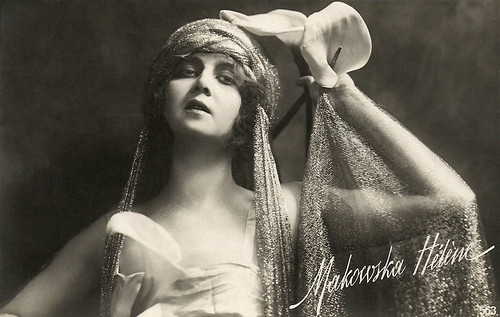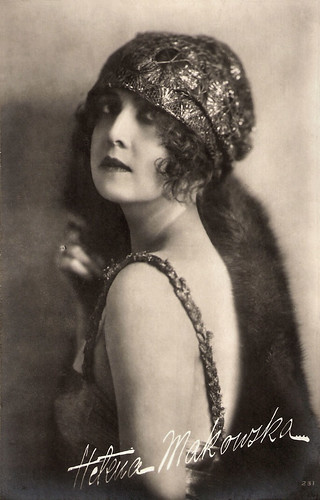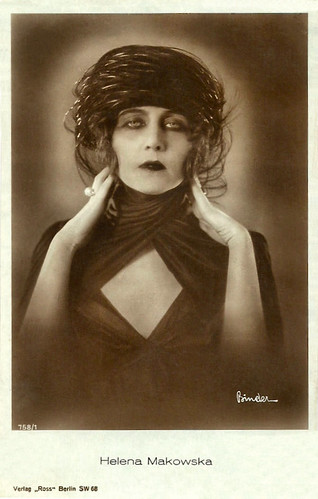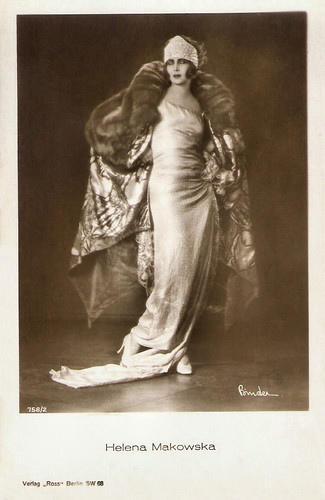Polish singer and actress Helena Makowska (1893 - 1964) was a beautiful diva of the Italian silent cinema in the 1910's. During the 1920's she moved to Berlin and became a star of the German cinema.
![Helena Makowska]()
Italian postcard, no. 30. Collection: Didier Hanson.
![Helena Makowska]()
Italian postcard by Ed. A. Traldi, Milano, no. 563.
Beautiful and a bit Stiff
Helena (also Elena) Makowska was born Helena Woynowiczówna in Krivoy Rog, Russian Empire (now Kryvyi Rih, Ukraine), in 1893. She was the daughter of Ludwik Woyniewicz, a Polish engineer who worked for a Russian-Belgian company, and his wife Stanislawa née Sauret. She returned to Warsaw. At the age of 16, she married lawyer Julian Makowski, but the marriage was a brief intermezzo. In 1912 Makowska went to Milan to take singing lessons. The following year she debuted at the Opera as Amelia in Il ballo in maschera and as Elena in Mefistofele. Her film debut was in the film Romanticismo (1915, Carlo Campogalliani, Arrigo Frusta). It was based on a famous play by Gerolamo Rovetta, which was already filmed in 1913, and refilmed in 1951. Makowska is Anna Lamberti, whose husband count Vitaliano Lamberti (Tullio Carminati) would like to join the partizans, but is withheld by his pro-Austrian mother. His indecision has estranged him from his wife, who has an affair with a Polish profugee, Cezky, Vitaliano's secretary. When Vitaliano finally joins the freefighting patriots, he regains his wife's confidence, but her vengeful lover denounces Vitaliano to the police, then commits suicide. Even when warned, Vitaliano stays where he is, is caught and executed. Romanticismo came out in Italy in September 1915, just a few months after the country had joined the Allied forces against Austria-Hungary and Germany in the First World War (April 1915). It was also her first film for the Torinese company Ambrosio. Makowska would go on to perform in some 40 Italian films until her move to Germany in the early 1920's. The Italian press constantly praised her beauty but found her a bit stiff. From 1917 on, she switched to other film companies and played Ophelia in Ruggero Ruggeri's Amleto/Hamlet (1917), the seductress Elena in the comedy Addio giovinezza/Good-bye Youth (1918, Augusto Genina) with Maria Jacobini, followed by La dame en gris/The Lady in Grey (1919, Gian Paolo Rosmino).
![Elena Makowska]()
Italian postcard.
![Elena Makowska in Romanticismo]()
Italian postcard by IPA, no. CT. 750. Photo: Film della Società Anonima Ambrosio, Torino (Turin). Still from Romanticismo (1915). Caption: Notte d'angoscia (Night of anguish).
German Prison Camp
In the early 1920's, Helena Makowska moved to Berlin, where she remarried with actor Karl Falkenberg. Between 1922 and 1927 Makowska played in some 15 films in Berlin and also in 3 in Warsaw, such as Judith/Frauen im Sumpf (1923) and Frauenmoral/Women's Morals (1923), both directed by Dutch director Theo Frenkel, Taras Bulba (1924, Vladimir Strizevsky, Joseph N. Ermolieff) with Oscar Marion, the Stuart Webbs-detective Der Schuss im Pavillion/The Shot in the Pavillion (1925, Max Obal), and Kochanka Szamoty/Szamota's Mistress (1927, Leon Trystan), her last film in Poland. After her return to Italy, rumors started to circulate that she had an affair with crown prince Umberto. In the early 1930's she married for the third time, now with an Englishman, Botteril, and returned to Poland, as an opera and operetta singer. In 1939, immediately after the Germans occupied Poland, she was arrested as a British citizen and in 1940 she was deported to Berlin. After four years of prison camp, she was liberated in occasion of an exchange of prisoners. In England she joined the theater ensemble of the Polish army, where she performed until the end of the war.
![Helena Makowska]()
Italian postcard.
![Helena Makowska]()
Italian postcard, no. 23. Collection: Didier Hanson.
Diva of Bygone Days
During her last years, Helena Makowska lived in Italy, where she did bit parts in Fabiola (1948, Alessandro Blasetti) starring Michèle Morgan and Henri Vidal, and Quo vadis? (1951, Mervyn LeRoy) with Robert Taylor and Deborah Kerr. She appeared in Luigi Comencini's melancholic La valigia dei sogni/The Suitcase of Dreams (1953) as the aged actress of the silent era who is visibly moved by the performances of Lyda Borelli in La Donna Nuda/The Naked Truth (1914, Carmine Gallone) and of herself in Fiacre 13/Cab Number 13 (1917, Alberto Capozzi, Gero Zambuto), one of her most popular films. In the film of Comencini, a modern audience of the 1950's cruelly laughs over the performances of the silent actresses, but the diva of bygone days sheds a tear over so much beauty and emotion. Her final film appearance was in Arrivederci Firenze/Goodbye Firenze (1958, Rate Furlan) with Maria-Pia Casilio. Helena Makowska died in 1964 in Rome, Italy. She was 71. In 1999 director Peter Delpeut included footage of Makowska, Lyda Borelli, Pina Menichelli and other Italian silent film stars in his beautiful compilation film Diva Dolorosa (1999).
![Helena Makowska]()
German postcard by Ross Verlag, no. 758/1, 1925-1926. Photo: Alex Binder. Collection: Didier Hanson.
![Helena Makowska]()
German postcard by Ross Verlag, no. 758/2, 1925-1926. Photo: Alex Binder.
Short clip from Diva Dolorosa (1999). Source: The Stat (YouTube).
Source: Vittoro Martinelli (Le dive del silenzio); Wikipedia (German) and IMDb.

Italian postcard, no. 30. Collection: Didier Hanson.

Italian postcard by Ed. A. Traldi, Milano, no. 563.
Beautiful and a bit Stiff
Helena (also Elena) Makowska was born Helena Woynowiczówna in Krivoy Rog, Russian Empire (now Kryvyi Rih, Ukraine), in 1893. She was the daughter of Ludwik Woyniewicz, a Polish engineer who worked for a Russian-Belgian company, and his wife Stanislawa née Sauret. She returned to Warsaw. At the age of 16, she married lawyer Julian Makowski, but the marriage was a brief intermezzo. In 1912 Makowska went to Milan to take singing lessons. The following year she debuted at the Opera as Amelia in Il ballo in maschera and as Elena in Mefistofele. Her film debut was in the film Romanticismo (1915, Carlo Campogalliani, Arrigo Frusta). It was based on a famous play by Gerolamo Rovetta, which was already filmed in 1913, and refilmed in 1951. Makowska is Anna Lamberti, whose husband count Vitaliano Lamberti (Tullio Carminati) would like to join the partizans, but is withheld by his pro-Austrian mother. His indecision has estranged him from his wife, who has an affair with a Polish profugee, Cezky, Vitaliano's secretary. When Vitaliano finally joins the freefighting patriots, he regains his wife's confidence, but her vengeful lover denounces Vitaliano to the police, then commits suicide. Even when warned, Vitaliano stays where he is, is caught and executed. Romanticismo came out in Italy in September 1915, just a few months after the country had joined the Allied forces against Austria-Hungary and Germany in the First World War (April 1915). It was also her first film for the Torinese company Ambrosio. Makowska would go on to perform in some 40 Italian films until her move to Germany in the early 1920's. The Italian press constantly praised her beauty but found her a bit stiff. From 1917 on, she switched to other film companies and played Ophelia in Ruggero Ruggeri's Amleto/Hamlet (1917), the seductress Elena in the comedy Addio giovinezza/Good-bye Youth (1918, Augusto Genina) with Maria Jacobini, followed by La dame en gris/The Lady in Grey (1919, Gian Paolo Rosmino).

Italian postcard.

Italian postcard by IPA, no. CT. 750. Photo: Film della Società Anonima Ambrosio, Torino (Turin). Still from Romanticismo (1915). Caption: Notte d'angoscia (Night of anguish).
German Prison Camp
In the early 1920's, Helena Makowska moved to Berlin, where she remarried with actor Karl Falkenberg. Between 1922 and 1927 Makowska played in some 15 films in Berlin and also in 3 in Warsaw, such as Judith/Frauen im Sumpf (1923) and Frauenmoral/Women's Morals (1923), both directed by Dutch director Theo Frenkel, Taras Bulba (1924, Vladimir Strizevsky, Joseph N. Ermolieff) with Oscar Marion, the Stuart Webbs-detective Der Schuss im Pavillion/The Shot in the Pavillion (1925, Max Obal), and Kochanka Szamoty/Szamota's Mistress (1927, Leon Trystan), her last film in Poland. After her return to Italy, rumors started to circulate that she had an affair with crown prince Umberto. In the early 1930's she married for the third time, now with an Englishman, Botteril, and returned to Poland, as an opera and operetta singer. In 1939, immediately after the Germans occupied Poland, she was arrested as a British citizen and in 1940 she was deported to Berlin. After four years of prison camp, she was liberated in occasion of an exchange of prisoners. In England she joined the theater ensemble of the Polish army, where she performed until the end of the war.

Italian postcard.

Italian postcard, no. 23. Collection: Didier Hanson.
Diva of Bygone Days
During her last years, Helena Makowska lived in Italy, where she did bit parts in Fabiola (1948, Alessandro Blasetti) starring Michèle Morgan and Henri Vidal, and Quo vadis? (1951, Mervyn LeRoy) with Robert Taylor and Deborah Kerr. She appeared in Luigi Comencini's melancholic La valigia dei sogni/The Suitcase of Dreams (1953) as the aged actress of the silent era who is visibly moved by the performances of Lyda Borelli in La Donna Nuda/The Naked Truth (1914, Carmine Gallone) and of herself in Fiacre 13/Cab Number 13 (1917, Alberto Capozzi, Gero Zambuto), one of her most popular films. In the film of Comencini, a modern audience of the 1950's cruelly laughs over the performances of the silent actresses, but the diva of bygone days sheds a tear over so much beauty and emotion. Her final film appearance was in Arrivederci Firenze/Goodbye Firenze (1958, Rate Furlan) with Maria-Pia Casilio. Helena Makowska died in 1964 in Rome, Italy. She was 71. In 1999 director Peter Delpeut included footage of Makowska, Lyda Borelli, Pina Menichelli and other Italian silent film stars in his beautiful compilation film Diva Dolorosa (1999).

German postcard by Ross Verlag, no. 758/1, 1925-1926. Photo: Alex Binder. Collection: Didier Hanson.

German postcard by Ross Verlag, no. 758/2, 1925-1926. Photo: Alex Binder.
Short clip from Diva Dolorosa (1999). Source: The Stat (YouTube).
Source: Vittoro Martinelli (Le dive del silenzio); Wikipedia (German) and IMDb.